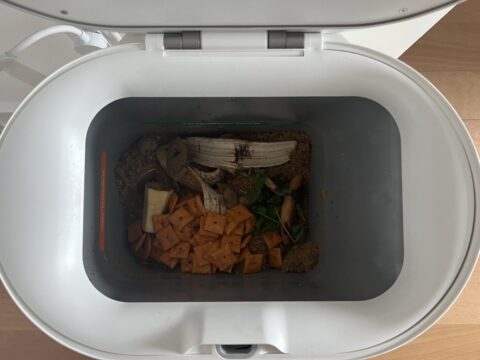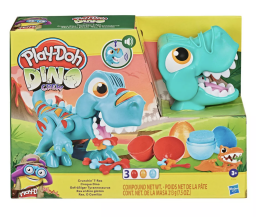Tackle your kitchen’s landfill footprint with the Mill food recycling bin, which offers a similar experience to composting at home in the form of reusing your food scraps as chicken food.

At-home composting has made serious moves in the past few years.
The most revolutionary was the move indoors. Electric countertop composters like the Vitamix FoodCycler and our beloved Lomi consolidated the composting process (which previously required outdoor space, several months of manual stirring, probably worms, and likely too much patience) to an appliance that doesn’t hog much more counter space than an Instant Pot. Instead of sitting idly and waiting to be emptied like the humble stainless steel countertop food scrap bin, they recycle the food scraps to a dirt-like material in a matter of hours.
Despite these advances in accessibility and simplicity — two major factors necessary to make the average person consider separating food scraps in their kitchen — this approach to countertop composting poses a recurring pickle: what to do with that material once it’s made. Mill fills the gap.
How does Mill work?
Mill is a large electric indoor food recycling bin that sits on the floor like a trash can instead of on the counter. Like an in-home composter, it’s a less-smelly place than the trash to throw plate scrapings, forgotten fridge leftovers, old pet food, and the butt of the bread that everyone keeps bypassing. Unlike composting, Mill technically isn’t conducting decomposition or creating a nutrient-rich substance that can be added to soil. Rather, Mill dries your scraps into dehydrated grounds that look and feel similar to dirt — literally your food without the moisture content — in just a few hours.

A look at the (shiny and new) interior of Mill and its spinning spoons.
Credit: Leah Stodart / Mashable

Mill is about the size of a 13-gallon trash can, so it does require a good chunk of kitchen floor space.
Credit: Leah Stodart / Mashable
But with those basics covered, Mill really starts to pull away from the competition. The most obvious physical difference is that Mill sits on the floor rather than the countertop and is basically like having another full-sized trash can in your kitchen. I love that opening the lid doesn’t require a hand to unscrew — the presser foot opens it for you.
Instead of waiting on you to press a button when the bucket is full like its countertop competitors, Mill automatically starts dehydrating and churning whatever you tossed in it that day. You can customize the starting time in the app, and I chose 10 p.m. to try to ensure that everyone in my household was done eating and snacking for the night. The sound of the lid locking was a bit of a jump scare the first few times, but then I literally just started using it to tell time. Oh, Mill just locked? Maybe don’t start a movie right now.
Of course, there have been several instances where somebody has something to put in the Mill after it locks. Conveniently, you can pause the cycle to unlock the lid by holding the button down. Mill automatically resumes afterward.

Lights on Mill’s lid indicate when it’s locked and running.
Credit: Leah Stodart / Mashable

Oh, to be a cat basking in the faint glow of the Mill bin.
Credit: Leah Stodart / Mashable
I actually don’t know exactly how long Mill runs overnight but it’s always done by the time I’m up for work the next morning. It’s also so much quieter than I expected (given the Lomi’s haunted house-esque creaking), producing a low whir that I only really notice when I’m standing near it.
Mill takes almost any food scrap, as well as most napkins and paper towels
Mill is super versatile in the variety of food you can put in it. The “yes” list is pretty self-explanatory and easy to remember, but you can get a quick refresher by glancing at the magnet that Mill sends with your bin. Being forced to glance at the magnet every time we open the fridge really helps to normalize separating food scraps in my apartment’s kitchen routine — scraping our plates into Mill is a reflex, just like the automatic reflex to throw a metal can into the recycling bin instead of the trash.
The fact that Mill’s list of what can go in the bin is heavier on the “yes” side than the “no” side also makes it easier to remember to use it over the trash can in the first place, especially for the people in the household who aren’t the hardcore eco-friendly ones.
A typical day with Mill: Cheez-Its, a banana peel, an apple core, and pizza crust.
Credit: Leah Stodart / Mashable
I remember my days of saving food scraps in a bag in my freezer to drop off at my local food scrap collection location in Brooklyn. Having to follow so many rules and Google what was acceptable on such a regular basis was a pain in the ass. “No meat, no dairy or cheese, no fats or oils, no cooked foods.” OK, so do you have to completely trash a salad if it has a few drops of dressing on it? Are steamed vegetables fine or not? Are you not even going to mention grains? Also, nobody knows what the hell carbon-rich or nitrogen-rich materials are. Explain it to me like I’m 5.
Most any food things can be thrown into Mill, and most of the “no” section is composed of non-food items that seem like common sense. There are some items, both food and non-food, that can go into Mill on a case-by-case basis, the terms of which are explained in the app when you search that item. For example, paper towels and napkins are safe as long as they’re 100 percent paper and don’t have cleaning product on them. The one main difference is that, while machines like Lomi and compost piles being used for fertilizer can use plant clippings, things like fallen houseplant leaves and yard scraps should be kept out of Mill.

Seeing the Mill magnet every time we open the fridge helps to internalize the general list of compostable items.
Credit: Leah Stodart / Mashable

Being able to search super specific items in the app is way easier than Googling.
Credit: Screenshot: Mill
If there’s further confusion about whether something specific can or can’t go in, it’s almost guaranteed to be listed in the Mill app, where you can type in the most random of food items and get a solid yes or no answer. I did this for the less obvious ones, like pet food (if you think wet cat food smells bad in the can, just wait until it’s been chilling in the trash for two days) and mixed-ingredient leftovers like pasta with cheese and sauce.
Mill covers shipping for optional mailing back of finished Food Grounds
Mill proves how much it really is consolidating your footprint by how long it takes for the bin to fill up. It was a bottomless pit for the first three months I was using it, holding weeks’ worth of daily food scrap dumping from three people and requiring literally no effort on my end. Once the grounds weighed 9 pounds and hit the green line inside, the app let me know it was time to empty.

The Mill bin is removable with handles for easy dumping into the box.
Credit: Leah Stodart / Mashable

The bag zips, so any smell will be sealed while you wait to add a second batch.
Credit: Leah Stodart / Mashable
From there, your only job is to pack your milled results into one of the pre-labeled packages that should have arrived in a separate delivery from the giant Mill box itself. These ship flat, so you’ll have to unfold one and place a planted-based plastic liner in it (also free with your membership). The shipping box can technically hold two full batches and the grounds don’t smell bad at all, so if you have a place to store the half-full box until your bin fills again, you’ll have to mail less often.
After scheduling a USPS pickup or dropping the package off at the post office, your scraps are Mill’s problem — and Mill ensures that your food scraps are actually being recycled.
Traditional compost feeds soil. Mill Food Grounds feeds chickens.
The way that Mill processes your scraps on demand on a daily basis is so cool and so different. But that’s hardly Mill’s sole unprecedented flex. Arguably even more impressive is the fact that Mill is so dedicated to recycling food that it puts your food waste directly back into the life cycle — into the belly of a chicken, actually.
The beef that any average Earth enjoyer has with the beef industry is spotlighted by countless documentaries and Impossible Whopper commercials. While cow farming is by far the biggest agricultural hazard for the climate, they’re not the only livestock practice with a hefty carbon footprint. A study about chicken and salmon farming published by Current Biology in February 2023 asserts that much of the emission — as much as 55 percent — associated with poultry farming comes from feeding them.
Factory-farmed chicken feed largely comes from grain and soya. Growing either requires mass amounts of land (often gained through deforestation) and water. The boom of demand for soybean products (ironically, the main base ingredient in a lot of plant-based meat) from humans and now chickens, apparently, is an increasing area of concern on top of the demand for the meat itself.
So, by rerouting your Mill grounds into the hands of farmers as an ingredient for their chicken feed, Mill’s closed-loop service can be thought of as an added measure of sustainability on top of the food scraps it diverts from landfills. According to an interview with NBC, the partnership with farmers also helps to subsidize the membership.
Mill’s mail-in collection and repurposing of your food scraps you make is the “No garden, no problem,” take that I could imagine a ton of apartment-dwelling Earth stans have been waiting for. Creating nutrient-rich fertilizer at home isn’t exactly a solution if you’re not maintaining any vegetation at home. That was one of my biggest gripes with the Lomi — plus the fact that the setting that works with paper products won’t produce fertilizer that should go into soil at all. Instead, they suggest putting that finished compost in the green bin. You mean, the green bin and curbside composting system that a ton of towns don’t have? Suggesting taking them to a local compost drop-off location kind of defeats the purpose of having a machine to do the composting at home.
How much does Mill cost?
Mill’s pricing diverges from the one-time, upfront payment situation that you’d expect. The bin itself is free, but it won’t ship without your subscription to an annual or monthly Mill service plan. The service plan covers optional pickups of those pre-labeled food ground packages whenever you want, connection to a support team of real people, plus maintenance like filters, repairs, and even bin replacement.
Here’s how the costs shake out: The cheaper of the two is the annual plan, which will run you $33 per month (billed upfront at $396 annually with free bin delivery) or the monthly plan, which is $45 month to month ($540 for a year) plus a $75 bin delivery. If you go with the annual plan, recycling food with Mill costs about dollar a day.
Taking all that Mill’s service does while it’s in your kitchen and beyond into account — plus the fact that it’s the only consumer food recycling option on the market that’s doing this — a dollar a day could be totally digestible for anyone with a somewhat disposable budget. If you don’t already pay for trash as part of your current utility bill (like I luckily don’t), you could also think of Mill as claiming that chunk that many others already have to budget for.
No, the loophole you’re thinking of won’t work, either. You can’t simply stop paying for the service while keeping the bin for free. Membership cancellation is only effective once Mill has received your returned bin, which you’ll have 30 days to send back after requesting to cancel your membership.
Mill versus Lomi and Vitamix: Cost is (almost) its only downside
Having Mill in my kitchen has been such a positive, hands-off experience that it hasn’t really sparked any noteworthy complaints. I’d be willing to bet that that’s what everyone will say — until the one-year mark rolls around and several hundred dollars disappear from your bank account again. The whole “dollar a day thing” adds up quickly, especially when you consider that a single year of using Mill is basically as expensive as the full one-time purchase of an indoor countertop composter.
So if you’re interested in composting inside your home but aren’t yet set on the specific machine, your main options aside from Mill are countertop composters like the Lomi, Reencle, or Vitamix FoodCycler. They operate similarly in that they still do the composting inside your home within a matter of hours — they just sit on your countertop and hold a much smaller capacity. These three go for around $400 to $600 at full price, maybe dropping by $100 or so when on sale. You’ll only have to pay that large chunk once rather than annually like you would with Mill, though most home composters do require purchase of filter and pod replacements every few months.
This isn’t to say that I don’t understand why Mill costs a bit more. It’s providing a wickedly convenient recurring service that no competitors can provide, and you’re paying for the experts to deal with your finished grounds rather than having to figure out what to do with it. I get it, but I’d be remiss not to put it into perspective, especially with steady inflation making us more closely considering what’s a necessity and what’s not.
Mill also sits on the floor while these competitors sit on the counter, and which would work better for you probably depends on the layout of your kitchen and whether you can give up counter space or floor space.
In my experience with having both Mill and Lomi in my apartment for several months, Lomi had several maintenance blips that required part replacement. Mill hasn’t glitched once. My guess is a lot of people would be willing to pay more for less upkeep and fewer chats with customer service agents.
Mill versus saving scraps for local pickup or drop-off
FWIW, a ton of people already pay for compost pickup. For instance, one service near me in Philadelphia charges $12 per month for every-other-week pickup, or $18 per month for weekly pickup. Mill’s service cost obviously still surpasses that by a bit, but paying to compost isn’t totally unheard of.
Then, there are the households that definitely want to divert their food scraps from the landfill but can’t decide whether it’s worthwhile to pay for their own composter or just take their scraps to a community compost site.
I just felt a shiver down my spine. Oh, no, I’m not cold — I’m just reflecting on my time saving my food scraps in my last two apartments. The smell that punched me in the face every time I took the lid off of the stainless steel countertop bin or the mystery drop of melty rotten freezer scrap juice that just fell on my foot. Four years of dedication to being a compost girlie means four years of experimenting with different methods of saving food scraps to take somewhere. After all of that, I can confidently confirm that being able to do the whole process in my home has been the easiest, the least gross, and so, so worth it.
Putting a number on Mill’s environmental benefits
I know, know — in a perfect world, a sleek, advanced system like Mill would be as standard and accessible in a home as curbside garbage collection is. It seems like we may actually be on the path to that (if you think that’s delusional, let me be delusional). States like California and Vermont haven’t yet awarded each resident and business with a Mill, but they do have statewide mandatory compost laws in place. Cities like San Fransisco and Portland are doing the same with citywide rules, and Brooklyn residents have access to citywide curbside composting as of October 2023. That’s supposed to expand to all of New York City by the end of 2024.
But until then, recycling food at home with something like Mill is still so impactful, even if you’re the only person you know who has one.
In case you’re blissfully unaware of just how detrimental our food waste habit really is, let’s get into it quickly. It’s estimated that the average American household wastes almost a third of the food it acquires each year, and that’s obviously not counting the contributions of food waste from businesses like restaurants.
When food rots, it produces methane: a gas that’s 80 times more potent than CO2 over a 20-year period after reaching the atmosphere. The combination of households, restaurants, and more creates 170 million metric tons of carbon dioxide-equivalent emissions — equivalent to the exhaust 37 million cars would create.
This is a statistic that Mill is aiming to shrink. One preliminary study done by Mill suggested that a year with Mill can avoid about a half-ton of greenhouse gas emissions at the single household level. Just think of the impact that could be had if Mill achieves its ultimate goal of expanding to the business level.
Is the Mill bin worth it?
Considering I spent my own money to purchase the free test unit I was sent to keep using Mill after I was done testing it, yes, I’d say Mill is worth it. It’s truly in a league of its own in the way that it’s currently the only at-home option on the market that will repurpose your food scraps. And though that aspect of it may sound a little fancy or obscure, Mill is ridiculously straightforward and easy to use. It’s literally like an extra 13-gallon trash can in your kitchen that takes itself out. Need I circle back to how much less rancid it is to discard food?
Mill simultaneously stirs hope and frustration because it shows just how easy it could and should be to not send every unwanted crumb from your kitchen to the landfill. Seriously, imagine if having a sustainable waste system like this at home was as normalized and accessible as trashing everything is. To me, it posed the daydream situation of how quickly America could turn its food waste shit show around if composting (or a composting-adjacent approach, like Mill’s) was funded on the micro level, rather than shifting the responsibility to the average person and whether or not they can figure out a convenient composting solution on their own dime.
UPDATE: Oct. 30, 2023, 4:40 p.m. EDT The original version of this review referred to Mill as a composter. It is actually a food recycler that dries and grinds food scraps rather than turning them into compost.























































